人教版(2019)高中英语必修第一册 Unit3Sports and fitness Discovering Useful Strucrures名师课件(共24张PPT)
文档属性
| 名称 | 人教版(2019)高中英语必修第一册 Unit3Sports and fitness Discovering Useful Strucrures名师课件(共24张PPT) |  | |
| 格式 | pptx | ||
| 文件大小 | 3.6MB | ||
| 资源类型 | 教案 | ||
| 版本资源 | 人教版(2019) | ||
| 科目 | 英语 | ||
| 更新时间 | 2023-03-08 16:49:33 | ||
图片预览

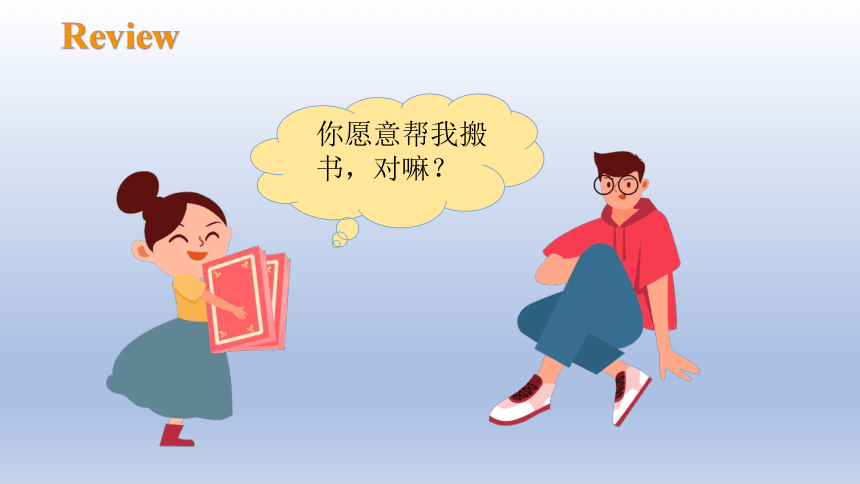
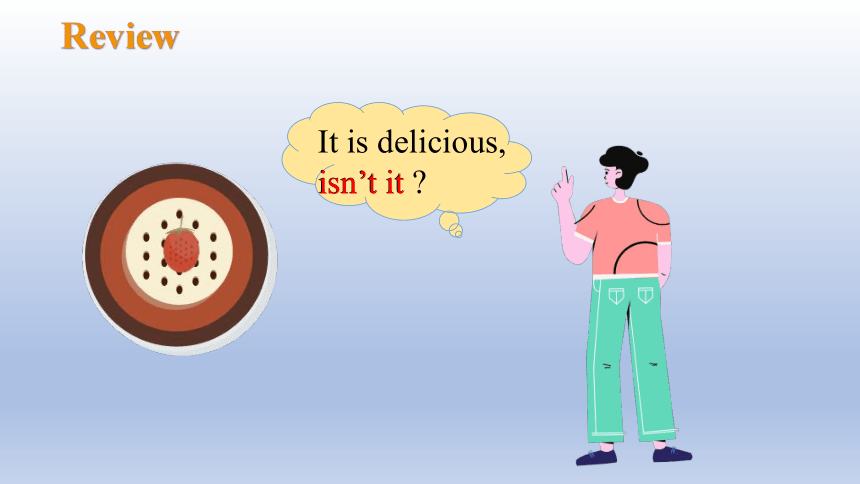
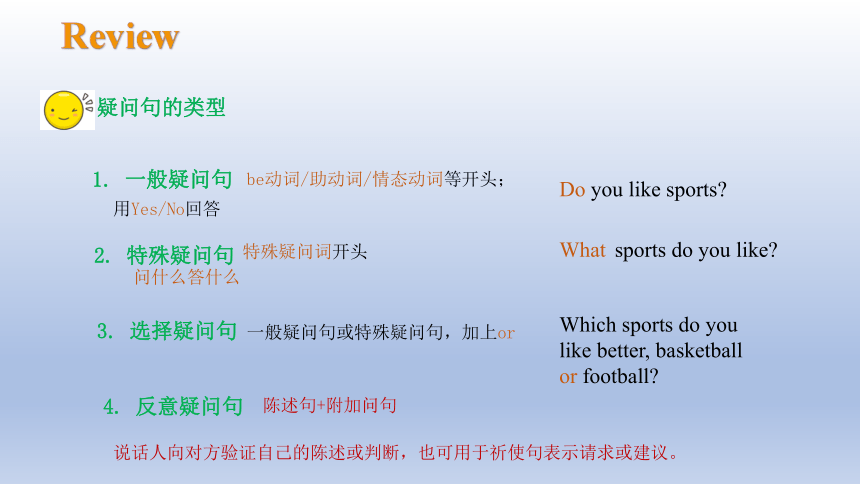
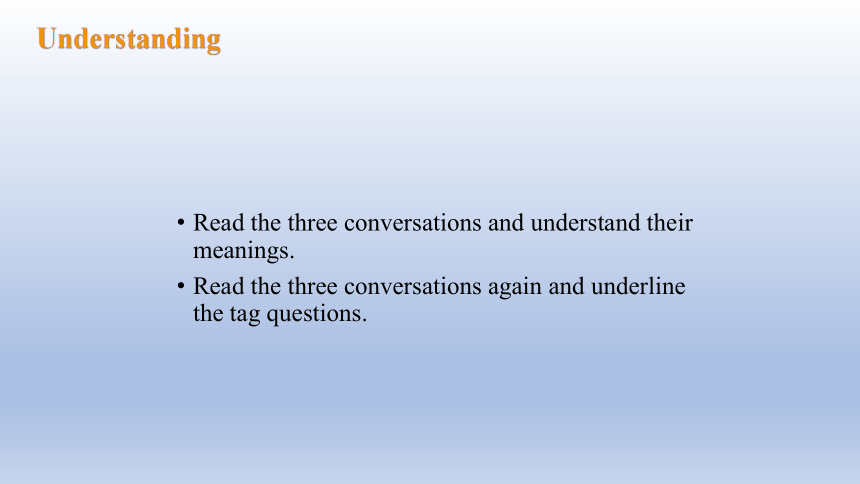
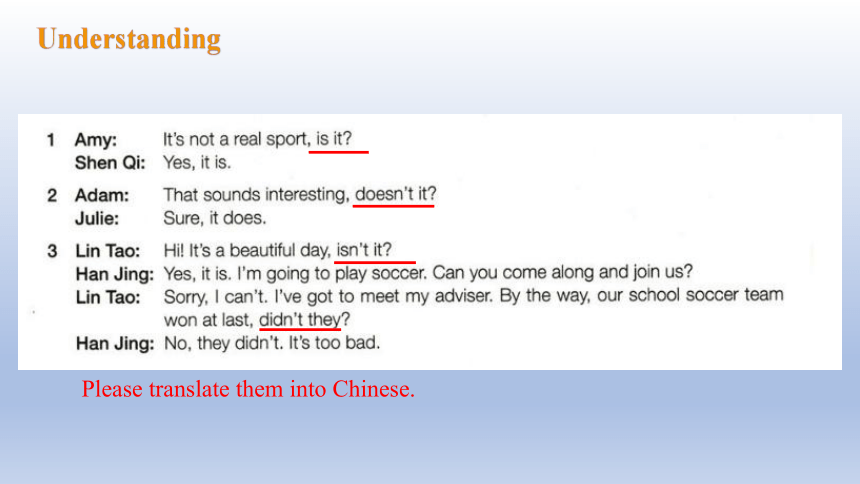
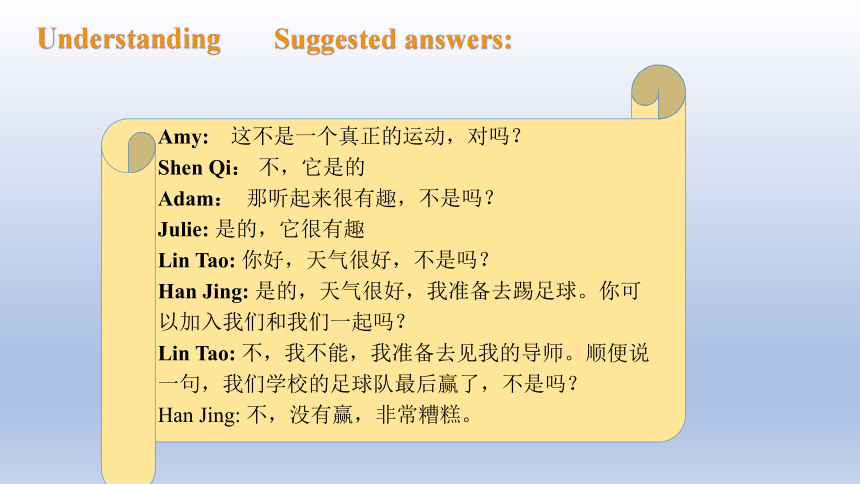
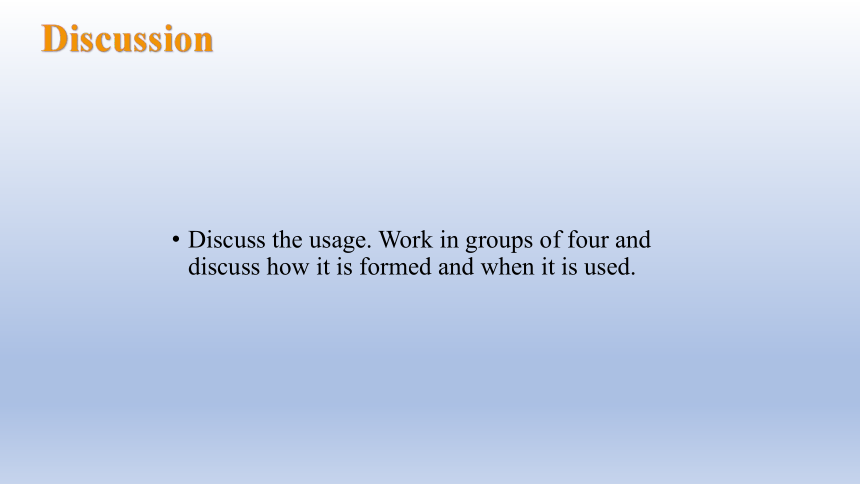
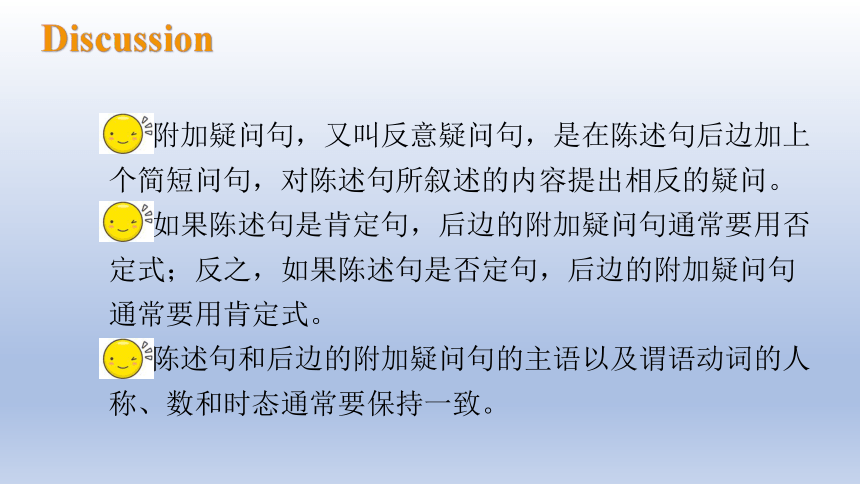
文档简介
(共24张PPT)
Unit3 Sports and Fitness
Discovering Useful Structures
Review
你愿意帮我搬书,对嘛?
It is delicious, isn’t it
isn’t it
Review
疑问句的类型
1. 一般疑问句
2. 特殊疑问句
3. 选择疑问句
4. 反意疑问句
be动词/助动词/情态动词等开头;
用Yes/No回答
特殊疑问词开头
问什么答什么
一般疑问句或特殊疑问句,加上or
Do you like sports
What sports do you like
Which sports do you like better, basketball or football
陈述句+附加问句
说话人向对方验证自己的陈述或判断,也可用于祈使句表示请求或建议。
Review
Understanding
Read the three conversations and understand their meanings.
Read the three conversations again and underline the tag questions.
Understanding
Please translate them into Chinese.
Understanding
Suggested answers:
Amy: 这不是一个真正的运动,对吗?
Shen Qi: 不,它是的
Adam: 那听起来很有趣,不是吗?
Julie: 是的,它很有趣
Lin Tao: 你好,天气很好,不是吗?
Han Jing: 是的,天气很好,我准备去踢足球。你可以加入我们和我们一起吗?
Lin Tao: 不,我不能,我准备去见我的导师。顺便说一句,我们学校的足球队最后赢了,不是吗?
Han Jing: 不,没有赢,非常糟糕。
Discussion
Discuss the usage. Work in groups of four and discuss how it is formed and when it is used.
附加疑问句,又叫反意疑问句,是在陈述句后边加上个简短问句,对陈述句所叙述的内容提出相反的疑问。
如果陈述句是肯定句,后边的附加疑问句通常要用否定式;反之,如果陈述句是否定句,后边的附加疑问句通常要用肯定式。
陈述句和后边的附加疑问句的主语以及谓语动词的人称、数和时态通常要保持一致。
Discussion
Understanding structure
He speaks English, doesn’t he?
Mary won’t do it, will she?
Lies cannot cover up the facts, can they?
Example
Understanding structure
回答附加疑问句和回答一般疑问句一样,肯定回答用Yes,+肯定结构.”,否定回答用“No,+否定结构.”。这与汉语习惯有所不同。如:
—He’s a doctor,isn’t he?
他是医生,对吧?
—Yes,he is./No,he isn’t.
对,他是医生。/不,他不是医生。
—He isn’t a doctor,is he?
他不是医生,对吧?
—Yes,he is./No,he isn’t.
不,他是医生。/对,他不是医生。
肯定:Yes+肯定结构
否定:No+否定结构
根据事实来回答
Nothing in the world is difficult, ________
This is Tom’s textbook, ________
These are your books, _________
Everyone knows that writer, ________
反意疑问句的主语
要与前面陈述句主语保持一致。
陈述句主语是that, this, those, these,反意疑问句的主语要用it或they。
陈述句主语是表示人的不定代词,如anyone, someone, no one, everybody, nobody, somebody等,
反意疑问句的主语通常用they。
陈述句主语是表示物的不定代词,如anything, nothing, something, everything等,
反意疑问句的主语用it。
isn’t it
aren’t they
don’t they
is it
Understanding structure
Smoking is not allowed here, ________
What he lacks is courage, ________
Let’s start early in the morning, shall we
Let us/me know your new address, will you
反意疑问句的主语
陈述句的主语是非谓语动词或主语从句,反意疑问句的主语用it。
Let’s与Let us/me后的反意疑问句主语不同。
陈述句如果是there be句型,反意疑问句的主语用there。
There is little water left, ________
要与前面陈述句主语保持一致。
is it
isn’t it
is there
Understanding structure
反意疑问句的助动词
要与前面陈述句助动词保持一致。
在含I am的陈述句之后,反意疑问句的助动词用aren’t。
I am supposed to be here, ________
陈述句谓语动词为have to时,反意疑问句用do作助动词。
当陈述句中have作“有”讲时,反意疑问句中既可用have作助动词也可用助动词do。
We have to take a test, ________
He has a good memory, _______________
陈述句的谓语动词含有used to时,反意疑问句多用did作助动词。
She used to live in London, didn’t she
aren’t I
don’t we
hasn’t/doesn’t he
Understanding structure
反意疑问句的助动词
陈述句中有情态动词must时
must表示“一定,准是”时,反意疑问句中助动词要与must后动词照应。
You must be very excited, aren’t you
You must have waited here for a long time, haven’t you
must表示“必须”时,反意疑问句中的助动词用mustn’t。
You must leave right now, mustn’t you
mustn’t表示“禁止”时,反意疑问句中的助动词用must或may。
You mustn’t walk on grass, must/may you
Understanding structure
反意疑问句用肯定还是否定
前肯后否,前否后肯
陈述句含有表示否定或部分否定意义的单词,如not, no, never, none, little, seldom,
hardly, few, nowhere, nothing等,看成否定句,反意疑问句用肯定。
Mary seldom goes to the cinema, does she
陈述句含有否定意思的词是unhappy, dislike, unfriendly等含有否定词缀的派生词,
看成肯定句,反意疑问句用否定。
He is unhappy, isn’t he
The girl dislikes history, doesn’t she
Understanding structure
陈述句是复合句或其他句子时
陈述句是主从复合句时,反意疑问句常重复复合句中主句的主语。
主句中如果有I think/believe/suppose这样的主谓结构时,反意疑问句重复从句主语。
You never told us why you didn’t pass the exam, did you
I don’t think she cares, does she
陈述句是并列句时,反意疑问句与后一个分句保持一致。
They were absent yesterday, but Mary wasn’t, was she
祈使句的反意疑问句常用will或can作助动词。祈使句为肯定句时,反意疑问句常
用will/won’t/can/can’t you;祈使句为否定句,反意疑问句则常用will/can you。
Please close the window, will/won’t/can/can’t you
Don’t take photos in the meeting room, will/can you
Understanding structure
Read the conversations and complete the conversations with appropriate tag questions or correct answers.
Understanding structure
Suggested answers:
Conversation 1: Yes,it is; can’t we; No, we can’t
Conversation 2: isn’t it; doesn’t she; No, she doesn’t
Conversation 3: isn’t he; is he; isn’t he
Practice
Practice
1. Learn the example.
A:The Sports Day is coming soon,isn’t it?
B:Yes, it is. They need some volunteers, don’t they
A:Yes, they do.
2. Work in groups and choose one situation
3. Role-play.
Excuse me. This is badminton hall, isn’t it
Yes, it is. Can I help
Practice
Example
Coach Wang works here, doesn’t he
Yes, he does. He is practising on the basketball court right now. It’s over there, next to the football pitch.
Practice
Example
Complete the conversations with appropriate tag questions or correct answers. Then act them out.
A: He likes playing football, doesn’t he
B: __________. It’s a good day for sports.
A: Then we can play football, ________
B: ___________. We don’t have a ball.
Yes, he does
can’t we
No, we can’t
A: His sister didn't attend the meeting, _______
B:___________
did she
Practice
Yes, she did
Practice
1. Write some conversations with appropriate tag questions.
2. Preview new lesson(s)
Unit3 Sports and Fitness
Discovering Useful Structures
Review
你愿意帮我搬书,对嘛?
It is delicious, isn’t it
isn’t it
Review
疑问句的类型
1. 一般疑问句
2. 特殊疑问句
3. 选择疑问句
4. 反意疑问句
be动词/助动词/情态动词等开头;
用Yes/No回答
特殊疑问词开头
问什么答什么
一般疑问句或特殊疑问句,加上or
Do you like sports
What sports do you like
Which sports do you like better, basketball or football
陈述句+附加问句
说话人向对方验证自己的陈述或判断,也可用于祈使句表示请求或建议。
Review
Understanding
Read the three conversations and understand their meanings.
Read the three conversations again and underline the tag questions.
Understanding
Please translate them into Chinese.
Understanding
Suggested answers:
Amy: 这不是一个真正的运动,对吗?
Shen Qi: 不,它是的
Adam: 那听起来很有趣,不是吗?
Julie: 是的,它很有趣
Lin Tao: 你好,天气很好,不是吗?
Han Jing: 是的,天气很好,我准备去踢足球。你可以加入我们和我们一起吗?
Lin Tao: 不,我不能,我准备去见我的导师。顺便说一句,我们学校的足球队最后赢了,不是吗?
Han Jing: 不,没有赢,非常糟糕。
Discussion
Discuss the usage. Work in groups of four and discuss how it is formed and when it is used.
附加疑问句,又叫反意疑问句,是在陈述句后边加上个简短问句,对陈述句所叙述的内容提出相反的疑问。
如果陈述句是肯定句,后边的附加疑问句通常要用否定式;反之,如果陈述句是否定句,后边的附加疑问句通常要用肯定式。
陈述句和后边的附加疑问句的主语以及谓语动词的人称、数和时态通常要保持一致。
Discussion
Understanding structure
He speaks English, doesn’t he?
Mary won’t do it, will she?
Lies cannot cover up the facts, can they?
Example
Understanding structure
回答附加疑问句和回答一般疑问句一样,肯定回答用Yes,+肯定结构.”,否定回答用“No,+否定结构.”。这与汉语习惯有所不同。如:
—He’s a doctor,isn’t he?
他是医生,对吧?
—Yes,he is./No,he isn’t.
对,他是医生。/不,他不是医生。
—He isn’t a doctor,is he?
他不是医生,对吧?
—Yes,he is./No,he isn’t.
不,他是医生。/对,他不是医生。
肯定:Yes+肯定结构
否定:No+否定结构
根据事实来回答
Nothing in the world is difficult, ________
This is Tom’s textbook, ________
These are your books, _________
Everyone knows that writer, ________
反意疑问句的主语
要与前面陈述句主语保持一致。
陈述句主语是that, this, those, these,反意疑问句的主语要用it或they。
陈述句主语是表示人的不定代词,如anyone, someone, no one, everybody, nobody, somebody等,
反意疑问句的主语通常用they。
陈述句主语是表示物的不定代词,如anything, nothing, something, everything等,
反意疑问句的主语用it。
isn’t it
aren’t they
don’t they
is it
Understanding structure
Smoking is not allowed here, ________
What he lacks is courage, ________
Let’s start early in the morning, shall we
Let us/me know your new address, will you
反意疑问句的主语
陈述句的主语是非谓语动词或主语从句,反意疑问句的主语用it。
Let’s与Let us/me后的反意疑问句主语不同。
陈述句如果是there be句型,反意疑问句的主语用there。
There is little water left, ________
要与前面陈述句主语保持一致。
is it
isn’t it
is there
Understanding structure
反意疑问句的助动词
要与前面陈述句助动词保持一致。
在含I am的陈述句之后,反意疑问句的助动词用aren’t。
I am supposed to be here, ________
陈述句谓语动词为have to时,反意疑问句用do作助动词。
当陈述句中have作“有”讲时,反意疑问句中既可用have作助动词也可用助动词do。
We have to take a test, ________
He has a good memory, _______________
陈述句的谓语动词含有used to时,反意疑问句多用did作助动词。
She used to live in London, didn’t she
aren’t I
don’t we
hasn’t/doesn’t he
Understanding structure
反意疑问句的助动词
陈述句中有情态动词must时
must表示“一定,准是”时,反意疑问句中助动词要与must后动词照应。
You must be very excited, aren’t you
You must have waited here for a long time, haven’t you
must表示“必须”时,反意疑问句中的助动词用mustn’t。
You must leave right now, mustn’t you
mustn’t表示“禁止”时,反意疑问句中的助动词用must或may。
You mustn’t walk on grass, must/may you
Understanding structure
反意疑问句用肯定还是否定
前肯后否,前否后肯
陈述句含有表示否定或部分否定意义的单词,如not, no, never, none, little, seldom,
hardly, few, nowhere, nothing等,看成否定句,反意疑问句用肯定。
Mary seldom goes to the cinema, does she
陈述句含有否定意思的词是unhappy, dislike, unfriendly等含有否定词缀的派生词,
看成肯定句,反意疑问句用否定。
He is unhappy, isn’t he
The girl dislikes history, doesn’t she
Understanding structure
陈述句是复合句或其他句子时
陈述句是主从复合句时,反意疑问句常重复复合句中主句的主语。
主句中如果有I think/believe/suppose这样的主谓结构时,反意疑问句重复从句主语。
You never told us why you didn’t pass the exam, did you
I don’t think she cares, does she
陈述句是并列句时,反意疑问句与后一个分句保持一致。
They were absent yesterday, but Mary wasn’t, was she
祈使句的反意疑问句常用will或can作助动词。祈使句为肯定句时,反意疑问句常
用will/won’t/can/can’t you;祈使句为否定句,反意疑问句则常用will/can you。
Please close the window, will/won’t/can/can’t you
Don’t take photos in the meeting room, will/can you
Understanding structure
Read the conversations and complete the conversations with appropriate tag questions or correct answers.
Understanding structure
Suggested answers:
Conversation 1: Yes,it is; can’t we; No, we can’t
Conversation 2: isn’t it; doesn’t she; No, she doesn’t
Conversation 3: isn’t he; is he; isn’t he
Practice
Practice
1. Learn the example.
A:The Sports Day is coming soon,isn’t it?
B:Yes, it is. They need some volunteers, don’t they
A:Yes, they do.
2. Work in groups and choose one situation
3. Role-play.
Excuse me. This is badminton hall, isn’t it
Yes, it is. Can I help
Practice
Example
Coach Wang works here, doesn’t he
Yes, he does. He is practising on the basketball court right now. It’s over there, next to the football pitch.
Practice
Example
Complete the conversations with appropriate tag questions or correct answers. Then act them out.
A: He likes playing football, doesn’t he
B: __________. It’s a good day for sports.
A: Then we can play football, ________
B: ___________. We don’t have a ball.
Yes, he does
can’t we
No, we can’t
A: His sister didn't attend the meeting, _______
B:___________
did she
Practice
Yes, she did
Practice
1. Write some conversations with appropriate tag questions.
2. Preview new lesson(s)
